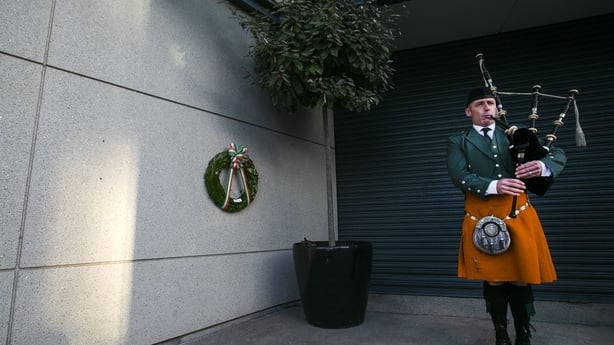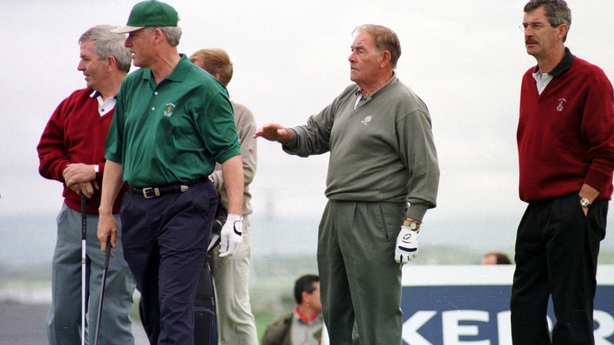By David McCullagh, Conor McMorrow and Justin McCarthy
The State Papers are the secret letters, memos and minutes written by politicians and civil servants as they wrestled with the problems of the day. They were not meant for the eyes of the public – until now.
Here are seven things we learned from the final day's release of documents:
1. Bloody Sunday compensation
Documents outlining the compensation paid to some of the relatives of the victims killed and injured in the Bloody Sunday attack in Croke Park in 1920 have been made available by the National Archives for the first time.
The files, which relate to ten of the victims, were rediscovered by the Department of Finance in a locked bunker in 2016 during refurbishment works.
They show that the family of 11-year-old William Robinson, who was shot through the lungs and died, received £50. The State files say that "he was sitting on the wall overlooking the Park when the Black & Tans entered the Park firing shots". He died at Whitworth Hospital in Drumcondra the following day.
Annie Burke, whose husband James died in the attack, was awarded £400, and a monthly allowance of £2 for her three youngest children, until they reached the age of 16.
The sister of James Hogan was awarded £40 for the death of her brother. He was shot in the shoulder, which led to his arm being amputated. Gangrene set in and he died five days after the shooting.
Father of five Thomas O'Connor, who worked as a barber, was awarded £75. He was shot in the right wrist and arm. His file states that he was out of work for six months and had to pay £3 a week to another man to do his work.

Mary Ryan, who sought £2,000 in compensation for the death of her husband Thomas, received £400 and a monthly allowance of £2 for her two daughters.
14 people died following the assault by British forces on 21 November 21, 1920, at Croke Park, during a challenge match between Dublin and Tipperary.
2. Cash for ash
The finance minister and taoiseach were powerless to reduce the spiralling cost of hurleys in January 1990.
Finance minister Albert Reynolds told the director general of the GAA that European law prevented him from slashing the cost of a hurley through tax cuts.
The GAA’s Liam Mulvihill had made a direct appeal in writing to taoiseach Charles Haughey, who passed the request straight to his finance minister.
According to newly released State Papers from 1990, the GAA’s top official said the cost of a hurley was making it "almost prohibitive for young people to take up our native game".
"Most other sporting sticks will last for a considerable time, whereas the average player needs several hurleys each year" he wrote. He pointed out that ash was in "a limited supply situation which leads to increased prices".
But Reynolds informed him that under European law he could not abolish tax on hurleys.
He said a European tax exemption existed for cultural services such as theatres and museums, but did not provide for a VAT "exoneration" for hurleys.
3. Reagan’s hotel hell
A diplomatic squabble over the logistics for US president Ronald Reagan’s visit to Ireland in 1984 is laid bare in confidential documents released as part of the State Archive.
The US contingent was annoyed with the Irish Government over a proposal to divide the White House support staff and US media outlets travelling with the president among 41 different hotels in the west of Ireland.
Counselor at the US Embassy, John A Boyle, wrote that the US forward planners were "very disappointed over the inability to secure overnight facilities for the staff and press as assured in previous conversation".
He added: "We feel that 41 different hotels is logistically impossible.
State Papers 1997-98: The hard slog towards agreement
Keeping a 'frightened' Trimble onside
The whispering campaign against Mo Mowlam
"We would again suggest that the Government of Ireland attempt to 'trade' current reservation holders among the various hotels in an attempt to secure more rooms in fewer hotels for the White House staff.
"It was under these assurances that we agreed to accept the Government of Ireland's invitation to visit the west coast. The original plan to overnight in Dublin and helicopter to Galway and Ballyporeen as a day trip may be the only feasible solution.
"We request that the Government of Ireland renew its efforts to consolidate hotel rooms in the Galway area."
The file notes that Bord Failte warned the US Embassy that it was responsible for paying for booked rooms, and that its decision to cancel accommodation in the Corrib Great Southern could result in the Embassy having to accept any financial liability arising.
4. Haughey supports ban on hunting otters
Charles Haughey enjoyed aristocratic sports like shooting, fishing, and horse riding, but he apparently drew the line at otter-hunting.
Otters are a protected species in Ireland, and have been since 1976, but a small number of hunting licences were issued up until 1990, when the taoiseach was asked to introduce a total ban on the pursuit.
The request came from his colleague Brendan Daly, a minister of state at the Department of Finance, who wrote to the Taoiseach seeking assistance with the "vexed question" of otter-hunting.
He said licences were usually granted to four hunts, and he had to make a decision as to whether to continue to grant the licences before the end of March.
"While the numbers of otters reported killed in these organised hunts are not large, and could not be claimed to have a serious effect on the otter population, both my predecessors and I have been under considerable pressure to discontinue the issue of licences for otter-hunting," he wrote.
In an information note Mr Daly said "The otter is not a pest like the fox. It is therefore difficult to argue in favour of the practice of hunting."
Mr Haughey, in a handwritten note said: "I agree that there should be no licences issued and this decision should be announced".
Licences were suspended in 1990 and, ten years later, the hunting or killing of an otter became a criminal offence.
5. Daniel O'Connell’s death bed
Clerics in Rome appeared to have misplaced Daniel O’Connell’s death bed when a request for its return to Ireland was made 30 years ago.
The bed had come into the possession of the Irish College in Rome in 1926, eight decades after O’Connell’s death on 15 May 1847 in the Italian city of Genoa.
In 1991, the Office of Public Works approached the rector of the college, the then Monsignor Seán Brady, seeking the return of the bed, so that it could be put on display in Derrynane, Co Kerry, at a site managed by the OPW.
The ambassador said he had formed the impression that there was 'some embarrassment' on Monsignor Brady's part
But the Irish ambassador to Italy, Robin Fogarty, discovered that the issue seemed to be "one of some sensitivity".
On the basis of "very confidential information" the ambassador said he had formed the impression that there was "some embarrassment" on Monsignor Brady’s part, as it appeared that he was "quite unsure" of the bed’s location.
"As far as he knows it was at some stage dismantled and may be in a storeroom in the college," Mr Fogarty added.
It is unclear how the matter was finally resolved, but it appears that the bed was subsequently located, and transported back to Derrynane as requested.
6. Prussian princess’s jewels appeal
An appeal for help was made to President Patrick Hillery when Princess Christa of Prussia, the granddaughter of the last German Emperor, had her family jewels taken at gunpoint in Dublin in 1978.
Newly released files from the National Archive outline how the princess suffered an "unbelievably horrible experience".
'the Princess of Prussia is now working as an interior decorator in Munich'
The unsavoury incident is documented in a letter from the Irish Consul General in Bavaria, who pleaded the case for the princess, saying she was "very popular in Germany".
The diplomatic letter notes that she spent her holiday in Ireland every year, and on this occasion was a guest of a Cecile Coleman, in whose house she was "attacked and tied by masked men with machine guns".
"The family of Prussia has lost all its fortune during the two world wars, and the Princess of Prussia is now working as an interior decorator in Munich. She took her last family jewels with her to Ireland, and they were all robbed!
"Should you be able, dear President, to help in this matter I would be most grateful. Perhaps you know the Chairman of the insurance company."
The list of jewellery stolen included 30 glamorous pieces with a value of DM38,195.
The letter went on to state that both relevant ambassadors had been informed of the incident, and that efforts were being made for the financial loss of the robbery to be recouped by insurance.
7. Clinton’s Ballybunion bounty
When Bill Clinton and Dick Spring met at Martha’s Vineyard in September 1994, days after the first IRA ceasefire, plans were hatched for a visit to Ireland by the US president, for an increase in US aid and investment in the North, and for a round of golf in Ballybunion.
During the chat between the two men, Clinton told Spring that a joint public/private fund for Northern Ireland would be "an easier sell" for him in Congress because of tighter spending controls domestically.
In an exchange reported between the pair, Clinton joked that his performance on the golf course might determine the size of the US taxpayer contribution.

Spring said he was "not asking for two or three hundred million dollars" to which Clinton replied: "If I break 80 in golf you can have it!"
It was suggested that Clinton should play an Irish course, with Spring stating: "Tom Watson plays regularly in Ireland at Ballybunion."
Clinton replied that the Kerry links was indeed "a famous course".
The US president visited Ireland the following year, but it wasn’t until 1998 that he got to play golf in Ballybunion, where the round was famously marked with the erection of a bronze statue of the US President.
Based on documents now available to view in the National Archives of Ireland.

